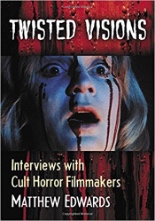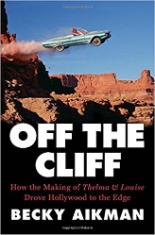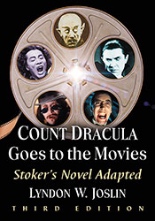 Fresh from editing last summer’s Klaus Kinski: Beast of Cinema book, Matthew Edwards follows up with another winner in McFarland & Company’s Twisted Visions: Interviews With Cult Horror Filmmakers. Just shy of two dozen directors sit for probing, lengthy Q&As; none are household names, unless your household is adorned with Nekromantik merch. (And if that’s the case, I politely decline your invitation for a sleepover.) Among the highlights: Alfred Sole reveals one of his actresses tried to kill herself during the Alice Sweet Alice shoot; Don’t Go in the House’s Joseph Ellison recalls facing the loaded rifle of the owner of the house they shot at; Rodrigo Gudiño traces his path from founder of Rue Morgue magazine to full-fledged filmmaker; and, in arguably the most interesting chapter, Jack Sholder spills the details about what an asshole Michael Nouri was throughout the making of The Hidden. Edwards is a strong interviewer, posing questions that have genuine thought behind them, which shows in the subjects’ passionate, candid responses.
Fresh from editing last summer’s Klaus Kinski: Beast of Cinema book, Matthew Edwards follows up with another winner in McFarland & Company’s Twisted Visions: Interviews With Cult Horror Filmmakers. Just shy of two dozen directors sit for probing, lengthy Q&As; none are household names, unless your household is adorned with Nekromantik merch. (And if that’s the case, I politely decline your invitation for a sleepover.) Among the highlights: Alfred Sole reveals one of his actresses tried to kill herself during the Alice Sweet Alice shoot; Don’t Go in the House’s Joseph Ellison recalls facing the loaded rifle of the owner of the house they shot at; Rodrigo Gudiño traces his path from founder of Rue Morgue magazine to full-fledged filmmaker; and, in arguably the most interesting chapter, Jack Sholder spills the details about what an asshole Michael Nouri was throughout the making of The Hidden. Edwards is a strong interviewer, posing questions that have genuine thought behind them, which shows in the subjects’ passionate, candid responses.
 In a summer when the overdue Wonder Woman has reigned supreme, one wonders if Ridley Scott’s Thelma & Louise didn’t give the Amazon princess a boost to smash the multiplex’s glass ceiling. In commemoration of the 1991 Oscar winner, Becky Aikman chronicles every step in its making — and subsequent leaps of influence — in Off the Cliff: How the Making of Thelma & Louise Drove Hollywood to the Edge. I only wish the Penguin Press release were at least half as compelling as the film it commemorates. While Aikman is a fine writer, initial chapters focusing on screenwriter Callie Khouri alone tend to overstate the stakes or create drama when there appears to be none, assumedly to support one exec’s quote that all the planets aligned for this one-in-a-million moonshot. Her you-are-there approach works once the film’s tortured, elongated, barrier-strewn development process begins, including Scott not in the director’s chair, Goldie Hawn lobbying hard for a lead and failed sitcom supporting player George Clooney auditioning for the small, shirtless role that eventually made a star out of one William Bradley Pitt. One of the strongest parts of Aikman’s book is the epilogue, in which Hollywood remains a boys’ club, despite T&L‘s Zeitgeist success. No argument there.
In a summer when the overdue Wonder Woman has reigned supreme, one wonders if Ridley Scott’s Thelma & Louise didn’t give the Amazon princess a boost to smash the multiplex’s glass ceiling. In commemoration of the 1991 Oscar winner, Becky Aikman chronicles every step in its making — and subsequent leaps of influence — in Off the Cliff: How the Making of Thelma & Louise Drove Hollywood to the Edge. I only wish the Penguin Press release were at least half as compelling as the film it commemorates. While Aikman is a fine writer, initial chapters focusing on screenwriter Callie Khouri alone tend to overstate the stakes or create drama when there appears to be none, assumedly to support one exec’s quote that all the planets aligned for this one-in-a-million moonshot. Her you-are-there approach works once the film’s tortured, elongated, barrier-strewn development process begins, including Scott not in the director’s chair, Goldie Hawn lobbying hard for a lead and failed sitcom supporting player George Clooney auditioning for the small, shirtless role that eventually made a star out of one William Bradley Pitt. One of the strongest parts of Aikman’s book is the epilogue, in which Hollywood remains a boys’ club, despite T&L‘s Zeitgeist success. No argument there.
 Another McFarland trade paperback, this one from Lyndon W. Joslin, gets a fresh coat of blood-red paint for its third edition: Count Dracula Goes to the Movies: Stoker’s Novel Adapted. More than half of the book finds the author comparing Bram Stoker’s 1897 epistolary classic to 18 subsequent screen adaptations, to see how faithful (or not) the likes of Tod Browning, Francis Ford Coppola, Werner Herzog, Jess Franco, Dario Argento and Mel Brooks are — or, as the case often is, are not. While Joslin knows Stoker’s text inside and out, reading scene-by-scene beats of each film is tiresome; I quickly found greater enjoyment skipping these synopses and diving straight into his commentary. Later, less-exhaustive chapters focus on the Universal sequels, the Hammer cycle and notable vampire flicks that owe more to the Hollywood matinee than the Gothic text, from AIP’s Count Yorga to the Wes Craven-presented Dracula 2000. This book inadvertently makes a terrific companion to the publisher’s recent Vampire Films of the 1970s. —Rod Lott
Another McFarland trade paperback, this one from Lyndon W. Joslin, gets a fresh coat of blood-red paint for its third edition: Count Dracula Goes to the Movies: Stoker’s Novel Adapted. More than half of the book finds the author comparing Bram Stoker’s 1897 epistolary classic to 18 subsequent screen adaptations, to see how faithful (or not) the likes of Tod Browning, Francis Ford Coppola, Werner Herzog, Jess Franco, Dario Argento and Mel Brooks are — or, as the case often is, are not. While Joslin knows Stoker’s text inside and out, reading scene-by-scene beats of each film is tiresome; I quickly found greater enjoyment skipping these synopses and diving straight into his commentary. Later, less-exhaustive chapters focus on the Universal sequels, the Hammer cycle and notable vampire flicks that owe more to the Hollywood matinee than the Gothic text, from AIP’s Count Yorga to the Wes Craven-presented Dracula 2000. This book inadvertently makes a terrific companion to the publisher’s recent Vampire Films of the 1970s. —Rod Lott
